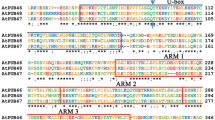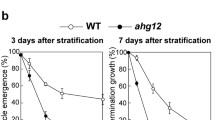Abstract
A gene encoding a protein with extensive homology to the largest subunit of the multicatalytic proteinase complex (proteasome) has been identified in Arabidopsis thaliana. This gene, referred to as AtPSM30, is entirely encompassed within a previously characterized radiation-induced deletion, which may thus provide the first example of a proteasome null mutation in a higher eukaryote. However, the growth rate and fertility of Arabidopsis plants do not appear to be significantly affected by this mutation, even though disruption experiments in yeast have shown that most proteasome subunits are essential. Analysis of mRNA levels in developing seedlings and mature plants indicates that expression of AtPSM30 is differentially regulated during development and is slightly induced in response to stress, as has been observed for proteasome genes in yeast, Drosophila, and mammals. Southern blot analysis indicates that the Arabidopsis genome contains numerous sequences closely related to AtPSM30, consistent with recent reports of at least two other proteasome genes in Arabidopsis. A comparison of the deduced amino acid sequences for all proteasome genes reported to date suggests that multiple proteasome subunits evolved in eukaryotes prior to the divergence of plants and animals.
Similar content being viewed by others
References
Akhayat O, Grossi De Sa F, Infante AA (1987) Sea urchin prosome: characterization and changes during development. Proc Natl Acad Sci USA 84:1595–1599
Arrigo A-P, Tanaka K, Goldberg AL, Welch WJ (1988) Identity of the 19S ‘prosome’ particle with the large multifunctional protease complex of mammalian cells (the proteasome). Nature 331:192–194
Brown JWS (1986) A catalogue of splice junction and putative branch point sequences from plant introns. Nucleic Acids Res 14:9549–9559
Church GM, Gilbert W (1984) Genomic sequencing. Proc Natl Acad Sci USA 81:1991–1995
Dean C, Tamaki S, Dunsmuir P, Favreau M, Katayama C, Dooner H, Bedbrook J (1986) mRNA transcripts of several plant genes are polyadenylated at multiple sites in vivo. Nucleic Acids Res 14:2229–2240
Devereux J, Haeberli P, Smithies O (1984) A comprehensive set of sequence analysis programs for the VAX. Nucleic Acids Res 12:387–395
Emori Y, Tsukahara T, Kawasaki H, Ishiura S, Sugita H, Suzuki K (1991) Molecular cloning and functional analysis of three subunits of yeast proteasome. Mol Cell Biol 11:344–353
Feinberg A, Vogelstein B (1984) A technique for radiolabeling DNA restriction fragments to high specific activity. Anal Biochem 137:266–267
Frentzel S, Troxell M, Haass C, Pesold-Hurt B, Glätzer KH, Kloetzel P-M (1992) Molecular characterization of the genomic regions of the Drosophila α-type subunit proteasome genes PROS-Dm28.1 and PROS-Dm35. Eur J Biochem 205:1043–1051
Friedman H, Goebel M, Snyder M (1992) A homolog of the proteasome-related RING10 gene is essential for yeast cell growth. Gene 122:203–206
Fujiwara T, Tanaka K, Kumatori A, Shin S, Yoshimura T, Ichihara A, Tokunaga F, Aruga R, Iwanaga S, Kakizuka A, Nakanish S (1989) Molecular cloning of cDNA for proteasomes (multicatalytic proteinase complexes) from rat liver: primary structure of the largest component (C2). Biochemistry 28:7332–7340
Fujiwara T, Tanaka K, Orino E, Yoshimura T, Kumatori A, Tamara T, Chung CH, Nakai T, Yamaguchi K, Shin S, Kakizuka A, Nakanishi S, Ichihara A (1990) Proteasomes are essential for yeast proliferation. J Biol Chem 265:16604–16613
Genschik P, Phillips G, Gigot C, Fleck J (1992) Cloning and sequence analysis of a cDNA clone from Arabidopsis thaliana homologous to a proteasome α subunit from Drosophila. FEBS Lett 309:311–315
Goldberg AL, Rock KL (1992) Proteolysis, proteasomes and antigen presentation. Nature 357:375–379
Haass C, Pesold-Hurt B, Multhaup G, Beyreuther K, Kloetzel P-M (1989) The PROS-35 gene encodes the 35 kd protein subunit of Drosophila melanogaster proteasome. EMBO J 8:2373–2379
Haffter P, Fox TD (1991) Nucleotide sequence of PUP1 encoding a putative proteasome subunit in Saccharomyces cerevisiae. Nucleic Acids Res 19:5075
Heinemeyer W, Kleinschmidt JA, Saidowsky J, Escher C, Wolf DH (1991) Proteinase yscE, the yeast proteasome/multicatalyticmultifunctional proteinase: mutants unravel its function in stress induced proteolysis and uncover its necessity for cell survival. EMBO J 10:555–562
Heinemeyer W, Gruhler A, Mohrle V, Mahe Y, Wolf DH (1993) PRE2, highly homologous to the human major histocompatibility complex-linked RING10 gene, codes for a yeast proteasome subunit necessary for chrymotryptic activity and degradation of ubiquitinated proteins. J Biol Chem 268:5115–5120
Kremp A, Schliephacke M, Kull U, Schmid H-P (1986) Prosomes exist in plant cells too. Exp Cell Res 166:553–557
Kubasek WL, Shirley BW, Mckillop A, Goodman HM, Briggs W, Ausubel FM (1992) Regulation of flavonoid biosynthetic genes in germinating Arabidopsis seedlings. Plant Cell 4:1229–1236
Kumatori A, Tanaka K, Inamura N, Sone S, Ogura T, Matsumoto T, Tachikawa T, Shin S, Ichihara A (1990a) Abnormally high expression of proteasomes in human leukemic cells. Proc Natl Acad Sci USA 87:7071–7075
Kumatori A, Tanaka K, Tamura T, Fujiwara T, Ichihara A, Tokunaga F, Onikura A, Iwanaga S (1990b) cDNA cloning and sequencing of component C9 of proteasomes from rat hepatoma cells. FEBS Lett 264:279–282
Lee DH, Tanaka K, Tamura T, Chung CH, Ichihara A (1992) PRS3 encoding an essential subunit of yeast proteasomes homologous to mammalian proteasome subunit C5. Biochem Biophys Res Commun 182:452–460
Orlowski M (1990) The multicatalytic proteinase complex, a major extralysosomal proteolytic system. Biochemistry 29:10289–10297
Pelham H (1985) Activation of heat-shock genes in eukaryotes. Trends Genet 1:31–35
Peterman TK, Goodman HM (1991) The glutamine synthetase gene family of Arabidopsis thaliana: light-regulation and differential expression in leaves, roots and seeds. Mol Gen Genet 230:145–154
Pinna LA (1990) Casein kinase 2: an “eminence grise” in cellular regulation? Biochim Biophys Acta 1054:267–284
Pühler G, Weinkauf S, Bachmann L, Müller S, Engel A, Hegerl R, Baumeister W (1992) Subunit stoichiometry and three-dimensional arrangement in proteasomes from Thermoplasma acidophilum. EMBO J 11:1607–1616
Sawada MT, Someno T, Hoshi M, Sawada H (1992) Participation of 650-kDa protease (20S proteasome) in starfish oocyte maturation. Dev Biol 150:414–418
Schaller A, Schmid J, Leibinger U, Amrhein N (1991) Molecular cloning and analysis of a cDNA coding for chorismate synthase from the higher plant Corydalis sempervirens Pers *. J Biol Chem 266:21434–21438
Schliephacke M, Kremp A, Schmid H-P, Kohler K, Kull U (1991) Prosomes (proteasomes) of higher plants. Eur J Cell Biol 55:114–121
Shirley BW, Ham DP, Senecoff JF, Berry-Lowe SL, Zurfluh LL, Shah DM, Meagher RB (1990) Comparison of the expression of two highly homologous members of the soybean ribulose-1,5-bisphosphate carboxylase small subunit gene family. Plant Mol Biol 14:909–925
Shirley BW, Hanley S, Goodman HM (1992) Effects of ionizing radiation on a plant genome: analysis of two Arabidopsis transparent testa mutations. Plant Cell 4:333–347
Takahashi T, Komeda Y (1989) Characterization of two genes encoding small heat-shock proteins in Arabidopsis thaliana. Mol Gen Genet 219:365–372
Tamura T, Lee DH, Osaka F, Fuhiwara T, Shin S, Chung CH, Tanaka K, Ichihara A (1991) Molecular cloning and sequence analysis of cDNAs for five major subunits of human proteasomes (multi-catalytic proteinase complexes). Biochim Biophys Acta 1089:95–102
Tanaka K, Yoshimura T, Kumatori A, Ichihara A, Ikai A, Nishigai M, Kameyama K, Takagi T (1988) Proteasomes (multi-protease complexes) as 20 S ring-shaped particles in a variety of eukaryotic cells. J Biol Chem 263:16209–16217
Weitman D, Edinger JD (1992) A monoclonal antibody that distinguishes latent and active forms of the proteasome (multicatalytic proteinase complex). J Biol Chem 267:6977–6982
Zwickl P, Lottspeich F, Dahlmann B, Baumeister W (1991) Cloning and sequencing of the gene encoding the large (α-) subunit of the proteasome from Thermoplasma acidophilum. FEBS Lett 278:217–221
Zwickl P, Griziwa A, Pühler G, Dahlmann B, Lottspeich F, Baumeister W (1992) Primary structure of the Thermoplama proteasome and its implications for the structure, function, and evolution of the multicatalytic proteinase. Biochemistry 31:964–972
Author information
Authors and Affiliations
Additional information
Communicated by E. Meyerowitz
GenBank accession number: M98495
Rights and permissions
About this article
Cite this article
Shirley, B.W., Goodman, H.M. An Arabidopsis gene homologous to mammalian and insect genes encoding the largest proteasome subunit. Molec. Gen. Genet. 241, 586–594 (1993). https://doi.org/10.1007/BF00279901
Received:
Accepted:
Issue Date:
DOI: https://doi.org/10.1007/BF00279901




